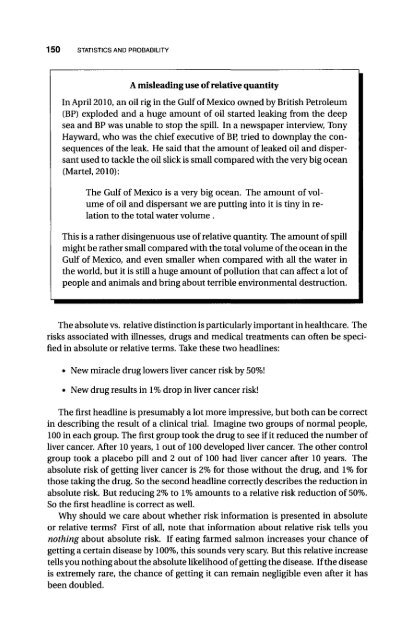An Introduction to Critical Thinking and Creativity - always yours
An Introduction to Critical Thinking and Creativity - always yours
An Introduction to Critical Thinking and Creativity - always yours
You also want an ePaper? Increase the reach of your titles
YUMPU automatically turns print PDFs into web optimized ePapers that Google loves.
150 STATISTICS AND PROBABILITY<br />
A misleading use of relative quantity<br />
In April 2010, an oil rig in the Gulf of Mexico owned by British Petroleum<br />
(BP) exploded <strong>and</strong> a huge amount of oil started leaking from the deep<br />
sea <strong>and</strong> BP was unable <strong>to</strong> s<strong>to</strong>p the spill. In a newspaper interview, Tony<br />
Hayward, who was the chief executive of BP, tried <strong>to</strong> downplay the consequences<br />
of the leak. He said that the amount of leaked oil <strong>and</strong> dispersant<br />
used <strong>to</strong> tackle the oil slick is small compared with the very big ocean<br />
(Martel, 2010):<br />
The Gulf of Mexico is a very big ocean. The amount of volume<br />
of oil <strong>and</strong> dispersant we are putting in<strong>to</strong> it is tiny in relation<br />
<strong>to</strong> the <strong>to</strong>tal water volume.<br />
This is a rather disingenuous use of relative quantity. The amount of spill<br />
might be rather small compared with the <strong>to</strong>tal volume of the ocean in the<br />
Gulf of Mexico, <strong>and</strong> even smaller when compared with all the water in<br />
the world, but it is still a huge amount of pollution that can affect a lot of<br />
people <strong>and</strong> animals <strong>and</strong> bring about terrible environmental destruction.<br />
The absolute vs. relative distinction is particularly important in healthcare. The<br />
risks associated with illnesses, drugs <strong>and</strong> medical treatments can often be specified<br />
in absolute or relative terms. Take these two headlines:<br />
• New miracle drug lowers liver cancer risk by 50%!<br />
• New drug results in 1% drop in liver cancer risk!<br />
The first headline is presumably a lot more impressive, but both can be correct<br />
in describing the result of a clinical trial. Imagine two groups of normal people,<br />
100 in each group. The first group <strong>to</strong>ok the drug <strong>to</strong> see if it reduced the number of<br />
liver cancer. After 10 years, 1 out of 100 developed liver cancer. The other control<br />
group <strong>to</strong>ok a placebo pill <strong>and</strong> 2 out of 100 had liver cancer after 10 years. The<br />
absolute risk of getting liver cancer is 2% for those without the drug, <strong>and</strong> 1% for<br />
those taking the drug. So the second headline correcüy describes the reduction in<br />
absolute risk. But reducing 2% <strong>to</strong> 1% amounts <strong>to</strong> a relative risk reduction of 50%.<br />
So the first headline is correct as well.<br />
Why should we care about whether risk information is presented in absolute<br />
or relative terms? First of all, note that information about relative risk tells you<br />
nothing about absolute risk. If eating farmed salmon increases your chance of<br />
getting a certain disease by 100%, this sounds very scary. But this relative increase<br />
tells you nothing about the absolute likelihood of getting the disease. If the disease<br />
is extremely rare, the chance of getting it can remain negligible even after it has<br />
been doubled.
















